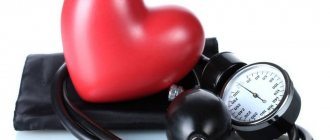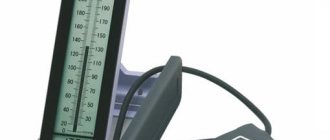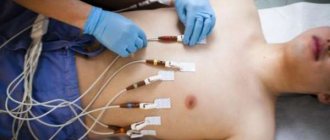Blood pressure (blood pressure) is an indicator indicating how much pressure blood exerts on the walls of blood vessels as it passes through them. The numbers depend on the elasticity of the vessels themselves and the pumping function of the heart muscle. This indicator is considered vital and requires regular monitoring. There is a device that allows you to measure blood pressure (BP) at home and in the hospital - a tonometer. The device can be mechanical, semi-automatic and automatic. Mechanical models are more often used. Next, we discuss how to measure pressure with a mechanical tonometer and how to interpret the results.
Operating principle of the device
A device for measuring blood pressure, regardless of whether it is mechanical or automatic, works according to one principle, namely:
- The cuff is put on.
- Air is pumped into it to compress the artery.
- The air is gradually removed from the cuff and the first pulse beat is recorded, which is the upper blood pressure (systolic).
- The last beat shows the lower (diastolic) blood pressure.
The value between the upper and lower readings is the pulse pressure. All modern semi-automatic, automatic and mechanical tonometers operate on this principle.
Sometimes the tonometer shows different pressure on the right and left arm. If the difference does not exceed 15 units, then there is usually nothing to worry about, but when it is greater than this indicator, then you need to be examined.
Differences in pressure can be caused by malfunctions of internal organs, VSD, diseases of the cardiovascular system, as well as simple stress and overwork. A slight increase in indicators on the left hand, especially if the person is left-handed, is allowed due to the nutrition of this limb by the aorta itself.
To understand how to correctly measure pressure yourself, you need to become more familiar with the features of the selected device. It is equally important to learn the rules that must be followed to obtain accurate data.
Features of a mechanical device for determining blood pressure
Based on one principle of operation, it is difficult to understand how to choose a tonometer for measuring pressure, so experts advise studying the features of each model. The mechanical appearance of the device is a set of tubes connecting a bulb, which pumps up air and deflates it, with a cuff that compresses the arteries. Even the best models of this type are quite cheap, but to measure blood pressure, you will have to additionally take a stethoscope. It is applied to the artery to hear the first and last beat. A mechanical tonometer is often sold together with a stethoscope, so it is advisable to find out about this nuance before purchasing.
Measuring blood pressure requires precision and professional skills, so not every type of device is suitable for a beginner. Mechanical tonometers can show the most accurate results and, when used correctly, have virtually no errors. However, if you give such a measuring device to an inexperienced person, or to a person with poor vision and hearing, the indicators may not be entirely accurate. That is why, before purchasing a mechanical device, you need to take into account the possible human factor, since measuring pressure with it is quite difficult.
There are simplified versions of a mechanical tonometer, for example, with a combined bulb and pressure gauge or a stethoscope head sewn into a cuff. Measuring pressure with such modifications is much easier and faster.
In general, measuring pressure with a mechanical tonometer has the following advantages:
- Always an accurate result if you figure out how to correctly measure pressure with a mechanical tonometer.
- In the presence of diseases of the cardiovascular system and arrhythmia, the device shows true indicators and without errors.
- Low price compared to other types of measuring instruments.
In some situations, measuring pressure with a mechanical tonometer is extremely inconvenient, namely:
- poor eyesight;
- hearing loss;
- problems with fine motor skills.
If you want to buy medical tonometers to measure blood pressure, then the mechanical option is one of them. Most modern hospitals work with such devices. After all, the experience of doctors allows them to obtain maximum accurate information without using an electronic tonometer.
Tonometers for measuring pressure are selected not only by features, but also by size. A standard cuff does not exceed 30 cm, a large one – 45 cm, and a children’s cuff no more than 22 cm. If the size does not fit, the blood pressure measurement will be inaccurate.
Instructions for using a mechanical tonometer
The instructions below will help anyone understand how to measure pressure with a mechanical tonometer:
- The person should sit on a chair with his back and legs straight. Next, you need to place your hand on the table, on which the pressure will be measured with a tonometer. If a person is right-handed, then it is better to carry out the procedure on the left limb, and vice versa. For a more accurate result, doctors advise taking measurements on both hands in turn.
- A cuff is placed on the arm 3 cm from the elbow bend and secured with Velcro.
- The stethoscope membrane is applied to the bend of the elbow.
- With the help of a bulb, air is supplied to the cuff. You need to stop pumping it 30 units after the last pulse beat heard.
- After reaching the required point, you need to turn the wheel a little under the pear. Air should come out no faster than 2 units per second. The first beat heard will be the upper pressure reading, and the last one will be the lower one.
This algorithm of actions represents the auscultatory measurement technique invented by N. S. Korotkov at the beginning of the twentieth century. In the absence of a stethoscope, the question of how to measure blood pressure becomes more pressing. The palpation method for determining values can help here. The technique will generally be identical to the auscultatory type, but in this case, instead of a stethoscope, the index and middle finger are used. The measurement accuracy does not change and the palpation method is well suited for people who have hearing problems.
There are certain rules by following which you can learn how to measure blood pressure correctly. Their list is as follows:
- Before measuring the baby’s blood pressure, he needs to be told about this procedure and asked to wait a couple of minutes. Usually this method helps, but in the case of children it is better to use automatic blood pressure monitors, as they show the result faster.
- Even the most modern blood pressure monitors will not show accurate numbers if a person is cold or hot. In one case, the vessels narrow and the pressure rises, and in the other they expand and it drops.
- Before measuring your blood pressure, it is advisable to rest for half an hour to calm down and relax.
How to measure your own blood pressure?
If necessary, a person can independently measure his or her blood pressure using this type of tonometer. The procedure is no different from the instructions described above. Only the phonendoscope is fixed with the edge of the cuff.
To ensure the accuracy of the indicators, the procedure can be repeated several times with a difference of about five minutes.
In the online store “A-Ya Zdorov” you can purchase high-precision devices for monitoring blood pressure at an affordable price. Go to selection.
Electronic models
Electronic blood pressure monitors operate using the oscillometric method. In their case, the use of a stethoscope is not required, the total numbers will be automatically shown on the screen. Measuring pressure with an electronic tonometer is extremely convenient for people with poor hearing and vision. One of the advantages is the ability to determine the number of heartbeats and the presence of arrhythmia. The results obtained can be saved in the device memory. Unlike a mechanical tonometer, even a child can use an electronic device, since measuring blood pressure is very simple and sometimes just pressing 1-2 buttons is enough.
An electronic tonometer can be automatic or semi-automatic. In the first case, it is enough to put on the cuff and press the button to start determining blood pressure. Semi-automatic blood pressure monitors are cheaper, but you have to pump the air manually. After reaching the required pressure, the device itself releases air.
The following algorithm will help you understand how to correctly measure pressure using semi-automatic tonometers:
- fix the cuff 3 cm from the elbow;
- pump air until the device is tightly connected and stop;
- look at the final result shown on the display.
With an automatic tonometer, the procedure is even easier. How to measure pressure correctly can be seen below:
- Fix the cuff and press the button located on the display.
- After completing the operation of the device, look at the display to familiarize yourself with the result.
Is it possible to measure for yourself?
Often people have to measure their blood pressure levels themselves at home. The order of measurements remains unchanged, the only difference is that the stethoscope must be pressed with a cuff to leave the hand free to pump air with the bulb.
Choosing a mechanical tonometer provides the opportunity to most accurately monitor the course of illnesses, identifying complications in people suffering from disorders of the heart and blood vessels, and the use of the above-described algorithm and recommendations helps resolve issues that may arise with the purchase of a mechanical device.
Subscribe to TechnoCouncil on social networks so you don’t miss anything:
Tonometer models
When choosing a mechanical device to determine the level of pressure, you can only find varieties for the shoulder. Among electronic tonometers there are models for measuring pressure on the wrist. They are good for people who have too large hands. When choosing between them, you need to consider the following features:
- On the wrist. Before purchasing such a tonometer, you need to make sure that the arteries in this place are not damaged, for example, due to the development of atherosclerosis, since the result will be inaccurate. If everything is normal, then blood pressure will be determined in a matter of seconds. A device for measuring pressure on the wrist is well suited for overweight people, as well as for those for whom it is important to constantly monitor their pressure, because it can be put in your pocket and always carried with you;
- On the shoulder. All types of devices for determining blood pressure have been created for this area. They are easy to operate and very accurate. Among the disadvantages is the large size.
If you have certain skills, it will not be difficult to understand how to measure pressure with a mechanical tonometer. However, due to poor hearing or vision, impaired hand motor skills and other reasons, many people cannot use such devices to determine blood pressure levels.
It is better for them to pay attention to automatic and semi-automatic blood pressure monitors. Such devices are more expensive, but they are easy to operate.
Decoding the results
The pressure gauge scale is divided into mmHg. Art. Minimum – 0 mm Hg. Art., and a maximum of 300 mm Hg. Art. Indicators above 200 mm Hg. Art. are considered critical and require immediate medical attention. One section of the scale corresponds to 2 mmHg. Art. When recording results, you must indicate two indicators, which are separated by the “/” sign. Examples of normal blood pressure: 110/70 mmHg. art., 125/80 mm Hg. Art.
If, when measuring your blood pressure, the readings are higher than normal, it is important to repeat the procedure after 5 minutes to check whether the increased blood pressure is associated with emotional experiences, physical activity or other physiological reasons. According to medical data, normal systolic pressure is a figure in the range of 91–139 mmHg. Art., diastolic – 61–89 mm Hg. Art. It is important to remember that a number of features of the body may slightly increase or decrease the permissible limits, and this will be considered the norm.
An increase in blood pressure is called hypertension, a persistent increase is called arterial hypertension. A decrease in levels is called hypotension. Both conditions can be at a safe or critical level. In the latter variation, the patient will need immediate medical attention.











